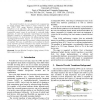Free Online Productivity Tools
i2Speak
i2Symbol
i2OCR
iTex2Img
iWeb2Print
iWeb2Shot
i2Type
iPdf2Split
iPdf2Merge
i2Bopomofo
i2Arabic
i2Style
i2Image
i2PDF
iLatex2Rtf
Sci2ools
CCECE
2006
IEEE
2006
IEEE
Reconfigurable Implementation of Wavelet Transform on an Fpga-Augmented NIOS Processor
The wavelet transform is a very popular tool in engineering for signal analysis. With respect to image compression, the new JPEG 2000 image standard incorporates wavelet transforms in its algorithm. Due to the high demands for processing and transmission, the trade-off of obtaining a high computation speed comes by sacrificing or reducing design flexibility. To meet the flexibility requirement, the Discrete Wavelet Transform is implemented on an FPGA-augmented NIOS processor [1]. In particular, the lifting scheme is given reconfigurable-hardware support. To incorporate the newly defined lifting unit into the core processor, custom instructions are defined. This way, an ASIP-Nios can be defined on the fly at the expenses of FPGA utilization and custom instructions. Performance of the proposed design highlights significant speed improvement over a pure software implementation.
CCECE 2006 | Discrete Wavelet Transform | Electrical And Computer Engineering | Incorporates Wavelet Transforms | Wavelet Transform |
| Added | 10 Jun 2010 |
| Updated | 10 Jun 2010 |
| Type | Conference |
| Year | 2006 |
| Where | CCECE |
| Authors | Eugene Hyun, Mihai Sima, Michael McGuire |
Comments (0)

